The seatbelt polyester yarn market is expected to expand from USD 1.3 billion in 2025 to USD 2.0 billion by 2035, at a CAGR of 4.2%, driven primarily by performance differences across denier segments. The 1000D segment, holding a dominant 62% share, forms the core of global demand due to its balanced tensile strength, elongation stability, and high compatibility with automotive webbing systems. Its ability to meet OEM safety specifications and maintain consistent load-bearing characteristics reinforces its position as the preferred yarn grade for modern restraint systems.
The 500D segment, representing 24% share, serves lightweight applications where reduced material mass and cost efficiency are prioritized. Growth in compact vehicles, specialized interior components, and weight-optimization programs supports its steady adoption among cost-focused manufacturers. Despite lower tenacity, its processing ease and dyeing adaptability maintain relevance across emerging markets. The 1500D segment, with a 10% share, serves heavy-duty and specialty applications. Its superior load-handling capacity positions it strongly in commercial vehicles, industrial harnesses, and high-strength aerospace or specialty safety equipment that require enhanced durability.
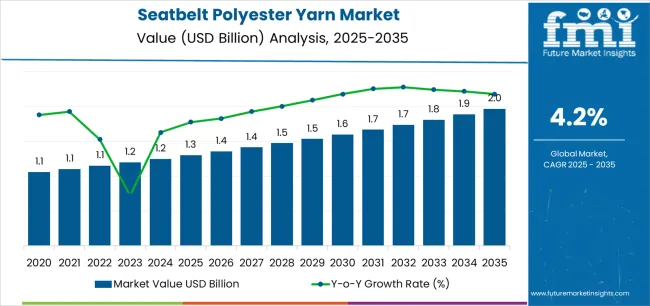
The latter half (2030-2035) will witness continued growth from USD 1.6 billion to USD 2.0 billion, adding USD 0.4 billion, or 55% of the decade's expansion. This period will be defined by mass market penetration of specialized denier technologies, integration with comprehensive quality management platforms, and seamless compatibility with existing automotive manufacturing infrastructure. The market trajectory signals fundamental shifts in how automotive facilities approach safety restraint systems and textile production operations, with participants positioned to benefit from growing demand across multiple denier specifications and application segments.
| Period | Primary Revenue Buckets | Share | Notes |
|---|---|---|---|
| Today | New yarn sales (500D, 1000D, 1500D) | 56% | Volume-driven, automotive OEM purchases |
| Dyed & treated yarn | 24% | Color processing, UV treatment, coating | |
| Custom specifications | 12% | Special tenacity, elongation requirements | |
| Technical services | 8% | Testing, quality certification | |
| Future (3-5 yrs) | High-performance yarn systems | 50-54% | Advanced polymer technology, enhanced durability |
| Treated & coated yarn | 22-26% | Specialized finishes, flame retardants | |
| Service-as-a-subscription | 10-14% | Performance guarantees, quality programs | |
| Custom solutions | 8-12% | Application-specific specifications, special treatments | |
| Testing & certification services | 6-9% | Regulatory compliance, quality assurance | |
| Digital tracking solutions | 2-4% | Batch tracking, quality analytics |
| Metric | Value |
|---|---|
| Market Value (2025) | USD 1.3 billion |
| Market Forecast (2035) | USD 2.0 billion |
| Growth Rate | 4.2% CAGR |
| Leading Technology | 1000D Yarn |
| Primary Application | Automotive Segment |
The market demonstrates strong fundamentals with 1000D yarn systems capturing a dominant share through advanced strength capabilities and automotive safety optimization. Automotive applications drive primary demand, supported by increasing vehicle production and safety restraint system requirements. Geographic expansion remains concentrated in developed markets with established automotive infrastructure, while emerging economies show accelerating adoption rates driven by vehicle manufacturing initiatives and rising safety standards.
Primary Classification: The market segments by denier into 500D, 1000D, 1500D, and other specialized yarn specifications, representing the evolution from standard textile materials to sophisticated safety solutions for comprehensive automotive restraint system optimization.
Secondary Classification: Application segmentation divides the market into automotive, aerospace, industrial safety equipment, and other sectors, reflecting distinct requirements for tensile strength, operational durability, and safety compliance standards.
Regional Classification: Geographic distribution covers North America, Latin America, Western Europe, Eastern Europe, East Asia, South Asia Pacific, and Middle East & Africa, with developed markets leading adoption while emerging economies show accelerating growth patterns driven by automotive manufacturing expansion programs.
The segmentation structure reveals technology progression from standard textile materials toward sophisticated safety yarns with enhanced strength and durability capabilities, while application diversity spans from automotive facilities to aerospace operations requiring precise high-performance textile solutions.
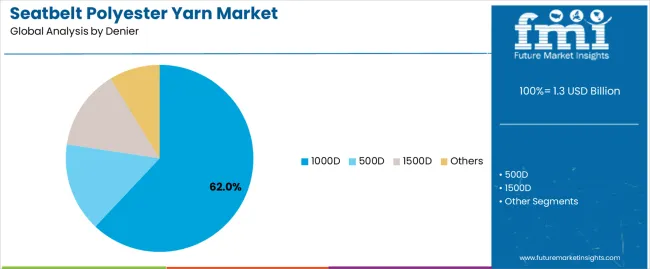
Market Position: 1000D yarn systems command the leading position in the market with 62% market share through advanced strength features, including superior tensile properties, operational reliability, and automotive safety optimization that enable manufacturing facilities to achieve optimal restraint system consistency across diverse automotive and aerospace environments.
Value Drivers: The segment benefits from automotive manufacturer preference for reliable textile systems that provide consistent strength performance, optimal elongation characteristics, and operational efficiency optimization without requiring significant processing modifications. Advanced design features enable balanced strength properties, processing compatibility, and integration with existing webbing equipment, where operational performance and safety compliance represent critical manufacturing requirements.
Competitive Advantages: 1000D yarn systems differentiate through proven operational reliability, consistent tensile characteristics, and integration with various weaving systems that enhance manufacturing effectiveness while maintaining optimal safety standards suitable for diverse automotive and aerospace applications.
Key market characteristics:
500D yarn systems maintain a 24% market position in the market due to their lightweight properties and processing advantages. These systems appeal to facilities requiring reduced weight with competitive pricing for specialized applications. Market growth is driven by automotive efficiency initiatives, emphasizing reliable safety solutions and weight optimization through specialized yarn designs.
1500D yarn systems capture 10% market share through specialized strength requirements in heavy vehicle applications, industrial safety equipment, and demanding automotive operations. These facilities demand high-tenacity yarn systems capable of handling extreme loads while providing effective safety capabilities and operational reliability.
Market Context: Automotive applications demonstrate the highest growth rate in the market with 4.6% CAGR due to widespread adoption of advanced safety systems and increasing focus on vehicle production optimization, safety compliance efficiency, and occupant protection applications that maximize safety performance while maintaining quality standards.
Appeal Factors: Automotive facility operators prioritize yarn reliability, strength consistency, and integration with existing webbing infrastructure that enables coordinated safety system production across multiple vehicle lines. The segment benefits from substantial automotive investment and safety technology programs that emphasize the acquisition of high-performance yarn systems for safety optimization and compliance efficiency applications.
Growth Drivers: Automotive manufacturing expansion programs incorporate seatbelt polyester yarn as standard material for safety restraint operations, while vehicle electrification growth increases demand for reliable textile capabilities that comply with safety standards and minimize weight penalties.
Market Challenges: Varying vehicle requirements and design complexity may limit yarn standardization across different platforms or safety scenarios.
Application dynamics include:
Aerospace applications capture market share through comprehensive safety requirements in aircraft restraint systems, aviation safety equipment, and aerospace component manufacturing. These facilities demand high-performance yarn systems capable of operating with stringent quality standards while providing effective strength access and operational reliability capabilities.
Industrial Safety Equipment applications account for market share, including fall protection equipment, industrial harnesses, and safety restraint systems requiring specialized textile capabilities for worker protection and operational safety.
| Category | Factor | Impact | Why It Matters |
|---|---|---|---|
| Driver | Growing vehicle production & safety regulations (global automotive expansion, mandatory restraint systems) | ★★★★★ | Expanding vehicle volumes drive consistent demand for seatbelt yarn; safety regulations make high-quality textile materials essential for compliance and occupant protection. |
| Driver | Advanced safety system integration & multi-point restraints (complex restraint designs, advanced webbing) | ★★★★☆ | Modern vehicles require sophisticated safety systems; advanced restraint configurations and pretensioner integration create sustained market opportunities. |
| Driver | Quality standards & automotive certification (ISO requirements, OEM specifications) | ★★★★☆ | Stricter quality requirements turn premium yarn from optional to mandatory; certification documentation and consistent properties become operational necessities. |
| Restraint | Raw material price volatility & petrochemical dependency (PET resin costs, supply chain disruption) | ★★★★☆ | Polymer price fluctuations impact margins; raw material cost instability and supply chain challenges create pricing pressure in established operations. |
| Restraint | Competition from alternative materials (nylon alternatives, advanced synthetics) | ★★★☆☆ | Alternative textile materials compete for applications; material diversification limits exclusive dependence on polyester yarn systems. |
| Trend | Advanced polymer technology & high-tenacity yarns | ★★★★★ | New polymer formulations and spinning technologies enhance strength; material innovation drives premium segment growth and reduces weight requirements. |
| Trend | Sustainable production & recycled polyester | ★★★★☆ | Circular economy initiatives and environmental requirements; recycled content and sustainable manufacturing become competitive differentiators. |
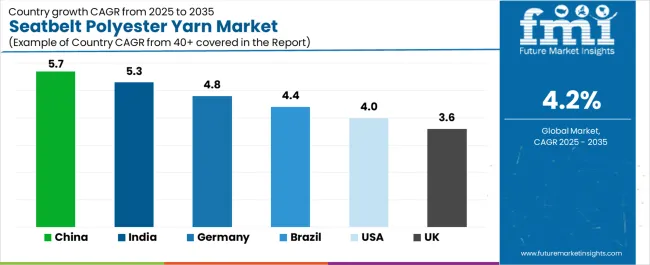
The market demonstrates varied regional dynamics with Growth Leaders including China (5.7% growth rate) and India (5.3% growth rate) driving expansion through automotive manufacturing initiatives and textile production capacity programs. Steady Performers encompass Germany (4.8% growth rate), Brazil (4.4% growth rate), and developed regions, benefiting from established automotive industries and safety textile technology adoption. Emerging Markets feature United States (4.0% growth rate) and developed regions, where automotive advancement and safety standardization support consistent growth patterns.
Regional synthesis reveals East Asian markets leading adoption through automotive expansion and textile manufacturing development, while South Asian countries maintain rapid expansion supported by vehicle production modernization and safety component requirements. Western European markets show moderate growth driven by automotive applications and quality integration trends.
| Region/Country | 2025-2035 Growth | How to win | What to watch out |
|---|---|---|---|
| China | 5.7% | Focus on cost-effective quality | Localization requirements; price competition |
| India | 5.3% | Lead with value systems | Infrastructure gaps; quality consistency |
| Germany | 4.8% | Offer premium performance | Over-specification; lengthy approval cycles |
| Brazil | 4.4% | Value-oriented solutions | Currency fluctuations; import duties |
| USA | 4.0% | Provide certification support | Market maturity; competitive pressure |
| UK | 3.6% | Push sustainable solutions | Budget pressures; procurement complexity |
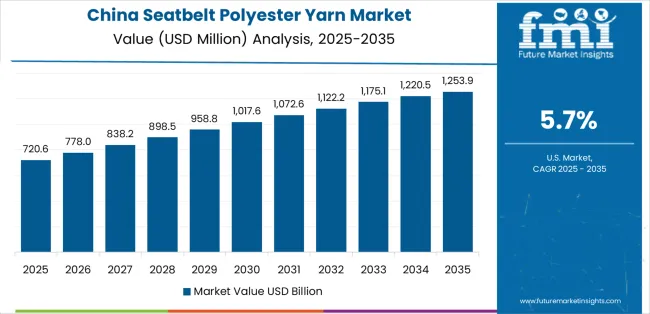
China establishes fastest market growth through aggressive automotive manufacturing programs and comprehensive textile production capacity expansion, integrating advanced seatbelt polyester yarn as standard material in vehicle safety system and automotive component installations. The country's 5.7% growth rate reflects government initiatives promoting automotive industry development and safety equipment manufacturing that mandate the use of high-quality textile materials in automotive and safety equipment facilities. Growth concentrates in major manufacturing centers, including Zhejiang, Jiangsu, and Guangdong, where automotive technology development showcases integrated textile systems that appeal to automotive operators seeking advanced safety optimization capabilities and compliance applications.
Chinese manufacturers are developing cost-effective textile solutions that combine domestic production advantages with advanced operational features, including high-tenacity capabilities and enhanced processing characteristics. Distribution channels through automotive equipment suppliers and textile manufacturing distributors expand market access, while government support for automotive development supports adoption across diverse automotive and safety equipment segments.
Strategic Market Indicators:
In Gujarat, Tamil Nadu, and Maharashtra, automotive facilities and textile operations are implementing advanced seatbelt polyester yarn as standard material for vehicle safety and manufacturing applications, driven by increasing government automotive investment and textile modernization programs that emphasize the importance of quality textile capabilities. The market holds a 5.3% growth rate, supported by government manufacturing initiatives and automotive infrastructure development programs that promote high-performance textile materials for automotive and safety equipment facilities. Indian operators are adopting textile materials that provide consistent operational performance and strength features, particularly appealing in urban regions where manufacturing quality and safety compliance represent critical operational requirements.
Market expansion benefits from growing automotive manufacturing capabilities and technology adoption programs that enable local production of textile materials for automotive and safety applications. Technology adoption follows patterns established in automotive equipment, where reliability and quality drive procurement decisions and operational deployment.
Market Intelligence Brief:
Germany establishes technology leadership through comprehensive automotive programs and advanced safety system development, integrating seatbelt polyester yarn across automotive and aerospace applications. The country's 4.8% growth rate reflects established automotive industry relationships and mature textile technology adoption that supports widespread use of high-performance materials in automotive and safety equipment operations. Growth concentrates in major automotive centers, including Baden-Württemberg, Bavaria, and Lower Saxony, where automotive technology showcases advanced textile deployment that appeals to automotive operators seeking proven safety capabilities and operational efficiency applications.
German equipment providers leverage established distribution networks and comprehensive service capabilities, including certification programs and quality support that create customer relationships and operational advantages. The market benefits from mature automotive standards and safety requirements that mandate textile material use while supporting technology advancement and operational optimization.
Market Intelligence Brief:
Brazil's market expansion benefits from diverse automotive demand, including manufacturing modernization in São Paulo and Minas Gerais, automotive facility upgrades, and government industrial programs that increasingly incorporate textile solutions for safety applications. The country maintains a 4.4% growth rate, driven by rising automotive activity and increasing recognition of high-quality textile benefits, including safety performance and enhanced manufacturing reliability.
Market dynamics focus on cost-effective textile solutions that balance advanced operational performance with affordability considerations important to Brazilian automotive operators. Growing automotive industrialization creates continued demand for modern textile materials in new facility infrastructure and manufacturing modernization projects.
Strategic Market Considerations:
The United States establishes market leadership through comprehensive automotive programs and advanced safety system development, integrating seatbelt polyester yarn across automotive and industrial safety applications. The country's 4.0% growth rate reflects established automotive industry relationships and mature textile technology adoption that supports widespread use of high-performance materials in automotive and safety equipment operations. Growth concentrates in major automotive centers, including Michigan, the Southeast, and California regions, where automotive technology showcases mature textile deployment that appeals to automotive operators seeking proven safety capabilities and compliance applications.
American equipment providers leverage established distribution networks and comprehensive service capabilities, including testing programs and certification support that create customer relationships and operational advantages. The market benefits from mature safety standards and automotive requirements that mandate textile material use while supporting technology advancement and safety optimization.
Market Intelligence Brief:
The United Kingdom's automotive technology market demonstrates seatbelt polyester yarn deployment with documented operational effectiveness in automotive applications and safety equipment facilities through integration with existing manufacturing systems and automotive infrastructure. The country leverages automotive expertise in safety technology and textile systems integration to maintain a 3.6% growth rate. Manufacturing centers, including the Midlands, Northwest, and Northeast, showcase installations where textile materials integrate with comprehensive automotive platforms and facility management systems to optimize production operations and safety effectiveness.
British automotive providers prioritize material quality and compliance in textile material procurement, creating demand for reliable materials with advanced features, including facility monitoring integration and quality assurance systems. The market benefits from established automotive technology infrastructure and a commitment to invest in safety technologies that provide operational benefits and compliance with national automotive standards.
Market Intelligence Brief:
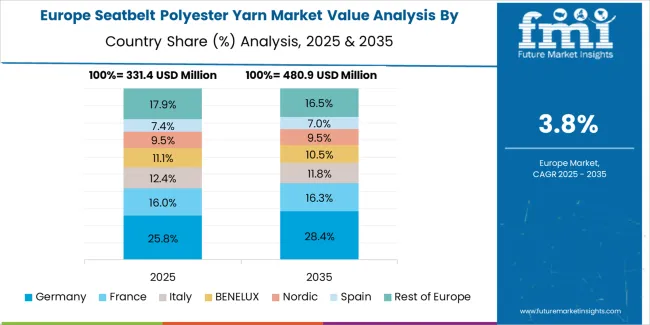
The European seatbelt polyester yarn market is projected to grow from USD 462.7 million in 2025 to USD 679.0 million by 2035, registering a CAGR of 3.9% over the forecast period. Germany is expected to maintain its leadership position with a 38.5% market share in 2025, supported by its advanced automotive infrastructure and comprehensive safety textile technology adoption.
France follows with a 23.9% share in 2025, driven by automotive modernization initiatives and safety system requirements. The United Kingdom holds a 16.8% share through established automotive networks and manufacturing standards. Italy commands a 12.1% share, while Spain accounts for 6.9% in 2025. The rest of Europe region is anticipated to gain momentum, expanding its collective share from 1.8% to 2.6% by 2035, attributed to increasing automotive adoption in Nordic countries and emerging Eastern European facilities implementing manufacturing modernization programs.

Japan demonstrates advanced automotive integration in seatbelt polyester yarn with comprehensive deployment across vehicle manufacturing and safety equipment facilities. The country maintains steady growth through automotive quality emphasis and safety precision requirements that support adoption of high-performance textile materials. Japanese automotive facilities prioritize strength and reliability in textile material procurement, creating consistent demand for premium yarn with advanced tenacity capabilities. Market characteristics include high adoption rates in urban manufacturing centers, established quality standards, and integration with comprehensive production management systems that optimize automotive workflows and safety programs.
South Korea establishes automotive innovation leadership through rapid adoption of advanced safety technologies and comprehensive manufacturing modernization programs. The country leverages technology infrastructure and automotive development initiatives to support seatbelt polyester yarn deployment across major automotive networks and safety equipment facilities. Korean automotive facilities emphasize quality and performance capabilities, driving demand for high-tenacity systems with advanced processing compatibility. Market growth benefits from government automotive investment, technology-focused procurement standards, and increasing emphasis on vehicle safety that position South Korea as a leading market for advanced textile solutions.

The market maintains a moderately consolidated structure with 15-20 credible players, where the top 4-5 companies hold approximately 60-68% market share by revenue. Leadership is maintained through comprehensive product portfolios spanning multiple denier specifications and strength grades, established automotive relationships, and global production networks that provide technical support, quality certification, and testing programs. Market leaders differentiate through technological innovation combining advanced polymer technology with specialized spinning processes, while also offering seamless integration with automotive manufacturing systems and quality assurance platforms.
Basic yarn production and standard denier specifications are commoditizing, shifting competitive advantage toward value-added services including specialized treatments, performance testing capabilities, and comprehensive quality documentation. Margin opportunities concentrate in premium segments with enhanced tenacity characteristics, specialized applications requiring custom specifications, and service contracts that provide quality guarantees and certification support. Companies investing in sustainable production technologies and recycled polyester platforms position themselves for premium market segments, while those focusing on efficient manufacturing and cost-effective quality solutions capture growth in emerging automotive markets and price-sensitive applications.
Strategic partnerships between yarn manufacturers and automotive OEMs create integrated offerings that simplify supply chains and ensure specification compliance. The competitive landscape reveals increasing emphasis on total quality solutions rather than standalone yarn products, with successful players offering comprehensive packages that address diverse safety needs across automotive manufacturing, aerospace applications, and industrial safety equipment. Technology advancement in high-tenacity polymer development and sustainable production creates differentiation opportunities, while testing capabilities and certification expertise remain fundamental requirements for market participation across developed automotive systems.
| Stakeholder | What they actually control | Typical strengths | Typical blind spots |
|---|---|---|---|
| Global platforms | Distribution reach, comprehensive product catalogs, production networks | Broad availability, proven reliability, multi-region support | Innovation speed; emerging market pricing flexibility |
| Technology innovators | Polymer R&D; advanced spinning; specialized treatments | Latest material technologies; attractive strength and durability | Distribution density outside core regions; price competitiveness |
| Regional specialists | Local compliance, rapid delivery, technical support | Close automotive relationships; pragmatic pricing; local standards | Technology gaps; scaling limitations |
| Service-focused ecosystems | Testing programs, certification support, quality services | Lowest operational disruption; comprehensive support | Service costs if overpromised; technology advancement |
| Niche specialists | Specialized applications, custom solutions, aerospace requirements | Win specialized and high-performance applications; flexible specifications | Scalability limitations; narrow market focus |
| Item | Value |
|---|---|
| Quantitative Units | USD 1.3 billion |
| Denier | 500D, 1000D, 1500D, Others |
| Application | Automotive, Aerospace, Industrial Safety Equipment, Others |
| Regions Covered | North America, Latin America, Western Europe, Eastern Europe, East Asia, South Asia Pacific, Middle East & Africa |
| Countries Covered | United States, China, Germany, India, United Kingdom, Japan, Brazil, France, South Korea, Canada, and 25+ additional countries |
| Key Companies Profiled | Toray, HYOSUNG, Indorama Ventures, INVISTA, SRF, Far Eastern New Century, Unifull, Coats Group, Hengli Group, Sanathan Textiles, Weaver (Xiamen) Textile, Oriental Industries (Suzhou), Zhejiang Hailide New Materials |
| Additional Attributes | Dollar sales by denier and application categories, regional adoption trends across East Asia, South Asia Pacific, and Western Europe, competitive landscape with textile manufacturers and automotive suppliers, automotive operator preferences for strength consistency and material reliability, integration with manufacturing systems and quality control platforms, innovations in polymer technology and spinning enhancement, and development of advanced textile solutions with enhanced performance and automotive safety optimization capabilities. |
The global seatbelt polyester yarn market is estimated to be valued at USD 1.3 billion in 2025.
The market size for the seatbelt polyester yarn market is projected to reach USD 2.0 billion by 2035.
The seatbelt polyester yarn market is expected to grow at a 4.2% CAGR between 2025 and 2035.
The key product types in seatbelt polyester yarn market are 1000d, 500d, 1500d and others.
In terms of , segment to command 0.0% share in the seatbelt polyester yarn market in 2025.






Our Research Products

The "Full Research Suite" delivers actionable market intel, deep dives on markets or technologies, so clients act faster, cut risk, and unlock growth.

The Leaderboard benchmarks and ranks top vendors, classifying them as Established Leaders, Leading Challengers, or Disruptors & Challengers.

Locates where complements amplify value and substitutes erode it, forecasting net impact by horizon

We deliver granular, decision-grade intel: market sizing, 5-year forecasts, pricing, adoption, usage, revenue, and operational KPIs—plus competitor tracking, regulation, and value chains—across 60 countries broadly.

Spot the shifts before they hit your P&L. We track inflection points, adoption curves, pricing moves, and ecosystem plays to show where demand is heading, why it is changing, and what to do next across high-growth markets and disruptive tech

Real-time reads of user behavior. We track shifting priorities, perceptions of today’s and next-gen services, and provider experience, then pace how fast tech moves from trial to adoption, blending buyer, consumer, and channel inputs with social signals (#WhySwitch, #UX).

Partner with our analyst team to build a custom report designed around your business priorities. From analysing market trends to assessing competitors or crafting bespoke datasets, we tailor insights to your needs.
Supplier Intelligence
Discovery & Profiling
Capacity & Footprint
Performance & Risk
Compliance & Governance
Commercial Readiness
Who Supplies Whom
Scorecards & Shortlists
Playbooks & Docs
Category Intelligence
Definition & Scope
Demand & Use Cases
Cost Drivers
Market Structure
Supply Chain Map
Trade & Policy
Operating Norms
Deliverables
Buyer Intelligence
Account Basics
Spend & Scope
Procurement Model
Vendor Requirements
Terms & Policies
Entry Strategy
Pain Points & Triggers
Outputs
Pricing Analysis
Benchmarks
Trends
Should-Cost
Indexation
Landed Cost
Commercial Terms
Deliverables
Brand Analysis
Positioning & Value Prop
Share & Presence
Customer Evidence
Go-to-Market
Digital & Reputation
Compliance & Trust
KPIs & Gaps
Outputs
Full Research Suite comprises of:
Market outlook & trends analysis
Interviews & case studies
Strategic recommendations
Vendor profiles & capabilities analysis
5-year forecasts
8 regions and 60+ country-level data splits
Market segment data splits
12 months of continuous data updates
DELIVERED AS:
PDF EXCEL ONLINE
Polyester Microfiber Fabric Market Size and Share Forecast Outlook 2025 to 2035
Polyester Shrink Film Market Size and Share Forecast Outlook 2025 to 2035
Polyester Polyol Market Size and Share Forecast Outlook 2025 to 2035
Polyester Hot Melt Adhesives Market Size and Share Forecast Outlook 2025 to 2035
Polyester Straps Market Size and Share Forecast Outlook 2025 to 2035
Polyester Fiber Market Size and Share Forecast Outlook 2025 to 2035
Polyester Labels Market – Growth & Demand 2025 to 2035
Polyester Resin Dispersion Market Analysis & Forecast by Viscosity Type, Process, End-Use Industry and Region through 2025 to 2035
Industry Share Analysis for Polyester Straps Companies
Spun Polyester Fabric Market Size and Share Forecast Outlook 2025 to 2035
Embossed Polyester Fabric Market Size and Share Forecast Outlook 2025 to 2035
Nonwoven Polyester Fabric Market Growth – Trends & Forecast 2025 to 2035
Saturated Polyester Resin Market Forecast Outlook 2025 to 2035
Demand for Polyester Shrink Film in UK Size and Share Forecast Outlook 2025 to 2035
Metallised Polyester Films Market Size and Share Forecast Outlook 2025 to 2035
Biodegradable Polyester Fiber Market Forecast and Outlook 2025 to 2035
High-Strength Polyester Thread Market Size and Share Forecast Outlook 2025 to 2035
Titanium Catalyst for Polyester Market Size and Share Forecast Outlook 2025 to 2035
Spun Yarn Paper Cone Market
Glass Fibre Yarn Market Size and Share Forecast Outlook 2025 to 2035

Thank you!
You will receive an email from our Business Development Manager. Please be sure to check your SPAM/JUNK folder too.
Chat With
MaRIA